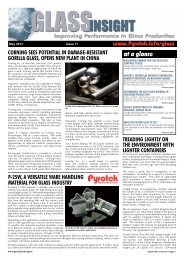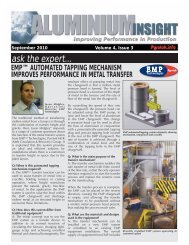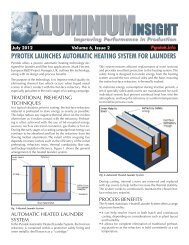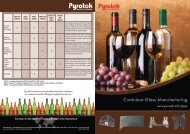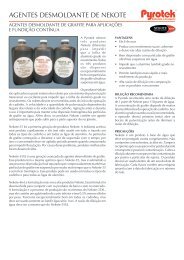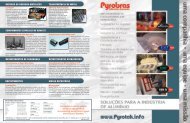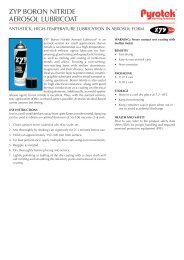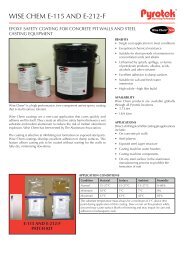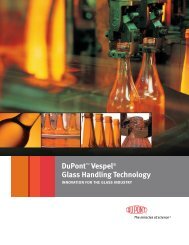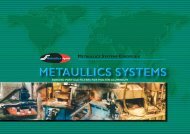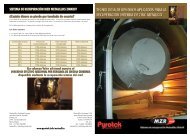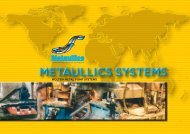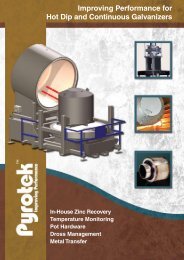Startup and Evaluation of the First SNIF SHEER⢠System ... - Pyrotek
Startup and Evaluation of the First SNIF SHEER⢠System ... - Pyrotek
Startup and Evaluation of the First SNIF SHEER⢠System ... - Pyrotek
- No tags were found...
Create successful ePaper yourself
Turn your PDF publications into a flip-book with our unique Google optimized e-Paper software.
<strong>Startup</strong> <strong>and</strong> <strong>Evaluation</strong><strong>of</strong> <strong>the</strong> <strong>First</strong> <strong>SNIF</strong> SHEER <strong>System</strong>at Kaiser Aluminum, Trentwood WorksbyJane E. Buehler, Kaiser Aluminum, Spokane, WA<strong>and</strong>Robert A. Frank, Praxair, Tarrytown, NYPresented at <strong>the</strong>122 nd TMS Annual MeetingDenver, ColoradoFebruary 24, 1993
PRELIMINARY DRAFT Page 1 <strong>of</strong> 23<strong>Startup</strong> <strong>and</strong> <strong>Evaluation</strong> <strong>of</strong> <strong>the</strong> <strong>First</strong> <strong>SNIF</strong> SHEER <strong>System</strong>at Kaiser Aluminum, Trentwood WorksJane E. Buehler, Kaiser Aluminum, Spokane, WARobert A. Frank, Praxair, Tarrytown, NYThe first, two-nozzle, <strong>SNIF</strong> SHEER system was installed <strong>and</strong> commissioned atKaiser, Trentwood Works in December 1991. The new system is an improved version <strong>of</strong><strong>the</strong> st<strong>and</strong>ard <strong>SNIF</strong>® "R" system. Following <strong>the</strong> system startup, an extensive evaluation <strong>and</strong>optimization was performed. A st<strong>and</strong>ard structural aluminum alloy (AA6061) was utilized.The performance <strong>of</strong> <strong>the</strong> refining system was measured as a function <strong>of</strong> <strong>the</strong> argon <strong>and</strong>chlorine flow rate. Hydrogen <strong>and</strong> inclusion removal were measured to determine <strong>the</strong>performance <strong>of</strong> <strong>the</strong> system. The conditions for optimal refining were determined. Acomparison <strong>of</strong> <strong>the</strong> performance <strong>of</strong> <strong>the</strong> new <strong>and</strong> st<strong>and</strong>ard systems was made.Author Data:Jane E. BuehlerKaiser Aluminum & Chemical Corp.Trentwood Works, P.O. Box 15108Spokane, WA 99215-5108Phone: (509)-927-6226 FAX: (509)-927-6101Robert A. FrankPraxair, Inc.777 Old Saw Mill River RoadTarrytown, NY 10591-6714Phone: (914)-789-2192 FAX: (914)-789-2506
PRELIMINARY DRAFT Page 2 <strong>of</strong> 23I. IntroductionOriginally constructed from 1942 to 1943, in Spokane, Washington, Kaiser Aluminum'sTrentwood Works has been modernized to become one <strong>of</strong> <strong>the</strong> most advanced flat-rolledproducts mills in <strong>the</strong> world. The principal products include beverage can end, tab, <strong>and</strong>body stock; heat-treated sheet, coil <strong>and</strong> plate; <strong>and</strong> common alloy coil <strong>and</strong> flat sheet.Trentwood serves several principal aluminum markets, including distributors,aircraft/aerospace manufacturers, beverage can producers, <strong>and</strong> <strong>the</strong> computer <strong>and</strong>transportation industries.The first <strong>SNIF</strong> SHEER (SHEER) system was installed at Trentwood Works in December1991 so that Kaiser could evaluate <strong>the</strong> increased performance <strong>of</strong> <strong>the</strong> new design.Conversion <strong>of</strong> <strong>the</strong>ir existing <strong>SNIF</strong>® (st<strong>and</strong>ard) systems to SHEER systems would allowmore high quality production with a minimal capital investment. This paper documents <strong>the</strong>performance <strong>of</strong> both st<strong>and</strong>ard <strong>SNIF</strong> <strong>and</strong> <strong>SNIF</strong> SHEER systems.II. Brief Description <strong>of</strong> Casting Line <strong>and</strong> New <strong>SNIF</strong> SHEER <strong>System</strong>The casthouse receives incoming metal from a variety <strong>of</strong> sources. The melter is chargedwith hot metal which can be prime from <strong>the</strong> reduction facility or remelted UBC <strong>and</strong> internalscrap. Cold metal sources include pig/sow, internal scrap, purchased scrap, <strong>and</strong> masteralloys. The charge will vary according to <strong>the</strong> type <strong>of</strong> alloy that is being made. Once <strong>the</strong>charge is melted, <strong>and</strong> <strong>the</strong> alloy is within compositional limits, it is processed by skimming<strong>and</strong> fluxing. The metal is <strong>the</strong>n transferred to <strong>the</strong> holder where it is fur<strong>the</strong>r processed. Uponcasting, <strong>the</strong> metal exits <strong>the</strong> holder <strong>and</strong> passes through a <strong>SNIF</strong> system <strong>and</strong> a ceramic foamfilter before entering <strong>the</strong> casting table.A <strong>SNIF</strong> system refines molten metal by injecting a process gas through a two-piecegraphite spinning nozzle equipped with a stator which permits high-speed rotation withoutvortexing. The nozzle's spinning action creates a large amount <strong>of</strong> fine bubbles which aredispersed throughout <strong>the</strong> melt. These gas bubbles clean <strong>the</strong> aluminum by desorbinghydrogen dissolved in <strong>the</strong> aluminum <strong>and</strong> by helping to carry harmful nonwetted, nonmetallicparticles (inclusions) up to <strong>the</strong> layer <strong>of</strong> dross floating on <strong>the</strong> metal surface. The <strong>SNIF</strong> R-140system is <strong>the</strong> st<strong>and</strong>ard two nozzle (two chamber) version <strong>of</strong> this system. Figure 1 shows across-sectional view <strong>of</strong> <strong>the</strong> st<strong>and</strong>ard system.The <strong>SNIF</strong> SHEER system incorporates changes to <strong>the</strong> chambers <strong>and</strong> nozzles whichincrease <strong>the</strong> efficiency <strong>of</strong> <strong>the</strong> system. A cross-sectional view <strong>of</strong> <strong>the</strong> <strong>SNIF</strong> SHEER R-140 isshown in Figure 2. A rib has been added to <strong>the</strong> bottom <strong>of</strong> each chamber. The rib helps tostabilize <strong>and</strong> equalize <strong>the</strong> metal flow pattern within <strong>the</strong> chamber. The nozzle modificationshelp to direct <strong>the</strong> two phase mixture (gas <strong>and</strong> metal) downward <strong>and</strong> distribute it evenlythroughout <strong>the</strong> chamber. These changes promote a better distribution <strong>of</strong> <strong>the</strong> bubbles, amore stable fluid pattern, a flat bath surface during processing <strong>and</strong> idle, <strong>and</strong> less splashingwhich increase <strong>the</strong> system efficiency <strong>and</strong> make it easier to maintain.
PRELIMINARY DRAFT Page 3 <strong>of</strong> 23III. Description <strong>of</strong> Experimental PlanThe performance <strong>of</strong> a st<strong>and</strong>ard <strong>SNIF</strong> system was measured under Kaiser's normaloperating conditions. This data served as <strong>the</strong> baseline for comparison <strong>of</strong> <strong>the</strong> <strong>SNIF</strong>SHEER system's performance. The performance <strong>of</strong> <strong>the</strong> SHEER system was measured asa function <strong>of</strong> <strong>the</strong> argon <strong>and</strong> chlorine flow rate. Rotor speed was also varied slightly, but thiswas done more to optimize <strong>the</strong> bubble pattern, not to affect <strong>the</strong> system performance.Although metal flow rate <strong>and</strong> alloy type can have a large effect on system performance,<strong>the</strong>y were held relatively constant throughout this study. The alloy used during <strong>the</strong> testingwas AA6061. Table I lists <strong>the</strong> major variables <strong>and</strong> <strong>the</strong> experimental values that were used.Table II lists all <strong>the</strong> major experimental conditions. An attempt was made to keep allremaining process variables as constant as possible. For each experiment, <strong>the</strong> metal wasmelted <strong>and</strong> prepared in a similar manner. Any exceptions were noted.The following data were ga<strong>the</strong>red for each experiment: general observations <strong>of</strong> <strong>the</strong> <strong>SNIF</strong>system <strong>and</strong> casting line, hydrogen levels before <strong>and</strong> after <strong>the</strong> <strong>SNIF</strong> system, <strong>and</strong> inclusionlevels before <strong>and</strong> after <strong>the</strong> <strong>SNIF</strong> system. During each experiment, as well as during idle,<strong>the</strong> surface <strong>of</strong> <strong>the</strong> bath in each chamber was observed. The bubble pattern, wave motion,amount <strong>of</strong> splashing, <strong>and</strong> amount <strong>of</strong> dross buildup were noted. Hydrogen levels weredetermined by <strong>the</strong> use <strong>of</strong> a Telegas I (by Praxair) <strong>and</strong> AlSCAN (by Kaiser) apparatus. Theinstruments were placed side by side <strong>and</strong> multiple measurements were made in eachlocation. This setup allowed for comparison <strong>of</strong> <strong>the</strong> instruments <strong>and</strong> duplication <strong>of</strong> <strong>the</strong> data.Two LAIS apparatus were used to sample <strong>the</strong> metal stream for inclusions. Kaiser used a500 g sample while Praxair used a 1000 g sample. Each sample was <strong>the</strong>n cut in half, <strong>and</strong>each company rated two halves. Thus, four values, two per sample, were obtained foreach location. The multiple samples allowed for comparison <strong>of</strong> rating scales <strong>and</strong>duplication <strong>of</strong> <strong>the</strong> measurements. To minimize <strong>the</strong> sampling time, hydrogen sampling wasdone on one side <strong>of</strong> <strong>the</strong> <strong>SNIF</strong> system while inclusion sampling was done on <strong>the</strong> oppositeside. The order <strong>of</strong> sampling, inlet versus outlet, was varied from experiment to experimentto prevent any bias from sampling order.IV. Results <strong>and</strong> DiscussionObservation <strong>of</strong> <strong>the</strong> <strong>SNIF</strong> systems at idle showed that <strong>the</strong> <strong>SNIF</strong> SHEER system provided abetter distribution <strong>of</strong> <strong>the</strong> gas bubbles than <strong>the</strong> st<strong>and</strong>ard system. This led to a flatter bathsurface, less splashing, less dross buildup, <strong>and</strong> less buildup on <strong>the</strong> ro<strong>of</strong>. On st<strong>and</strong>ardsystems, idle gas can sometimes exit <strong>the</strong> stator from only one side creating big bubbles<strong>and</strong> splash. With <strong>the</strong> SHEER nozzle, <strong>the</strong> idle gas is distributed evenly around all sides <strong>of</strong><strong>the</strong> stator. The result is a ring <strong>of</strong> small bubbles just around stator. The bubbles producevery little splash <strong>and</strong> do not disturb <strong>the</strong> majority <strong>of</strong> <strong>the</strong> bath surface. This meant that <strong>the</strong>dross <strong>and</strong> ro<strong>of</strong> buildup at idle, mainly due to idle gas splashing, are greatly reduced with<strong>the</strong> SHEER design. In fact, <strong>the</strong> dross <strong>and</strong> ro<strong>of</strong> buildup appeared to be less with <strong>the</strong>SHEER nozzle than with st<strong>and</strong>ard nozzles which are rotated during idle.
PRELIMINARY DRAFT Page 4 <strong>of</strong> 23During processing, <strong>the</strong> SHEER system produced gas bubbles that were evenly distributedthroughout each chamber, even into <strong>the</strong> corners. There was no evidence <strong>of</strong> <strong>the</strong>occasionally large bubbles, <strong>and</strong> associated splash, which are a result <strong>of</strong> instabilities in <strong>the</strong>metal flow patterns on st<strong>and</strong>ard systems. The telltale rolling motion <strong>of</strong> <strong>the</strong> surface inst<strong>and</strong>ard systems did not exist in <strong>the</strong> SHEER system. This eliminated most <strong>of</strong> <strong>the</strong> exittrough wave motion found with st<strong>and</strong>ard systems. The bath surface during processing wasnearly as flat as <strong>the</strong> surface at idle. The dross buildup <strong>and</strong> ro<strong>of</strong> buildup during processingmay also have been less, but this was hard to quantify. From a setup st<strong>and</strong>point, <strong>the</strong>SHEER system is much easier to "tune" than a st<strong>and</strong>ard system. When <strong>the</strong> bubble patternin <strong>the</strong> SHEER system becomes well distributed, <strong>the</strong> bath surface changes dramaticallyfrom a point slightly rougher than a st<strong>and</strong>ard system to a flat surface. The motor currentalso increases about one amp while <strong>the</strong> speed remains virtually constant. This makes iteasy to monitor whe<strong>the</strong>r <strong>the</strong> system is running correctly by watching <strong>the</strong> combination <strong>of</strong>process gas flow, rotor speed, <strong>and</strong> motor current.Table III provides <strong>the</strong> hydrogen results for each <strong>of</strong> <strong>the</strong> major experiments. Included in <strong>the</strong>table are two sets <strong>of</strong> values calculated from <strong>the</strong> hydrogen levels: <strong>the</strong> hydrogen removal<strong>and</strong> <strong>the</strong> reactor (system) constant. Hydrogen removal is <strong>the</strong> amount <strong>of</strong> hydrogen removedby <strong>the</strong> <strong>SNIF</strong> system, in percent, as defined by equation 1:% Removal ’ 100 H i &H fH iwhere:H i = Inlet Hydrogen Concentration (cc/100g)H f = Outlet Hydrogen Concentration (cc/100g)The reactor constant is a number which describes how efficiently <strong>the</strong> <strong>SNIF</strong> system isoperating. It is based on <strong>the</strong> st<strong>and</strong>ard chemical engineering equation for a well-mixed,steady state, staged reactor. 1 This model has previously been applied to in-linedegassing systems. 2,3,4 The reactor constant is defined by equation 2:k ’ v Aln v Ar1H i s &1H fwhere:H i = Inlet Hydrogen Concentration (cc/100g)H f = Outlet Hydrogen Concentration (cc/100g)
PRELIMINARY DRAFT Page 5 <strong>of</strong> 23v Ar = Argon Flow Rate per Nozzle (cfh)v Al = Aluminum Flow Rate (ton/hr)n = number <strong>of</strong> nozzles per stage (-) = 1 for st<strong>and</strong>ard <strong>and</strong> SHEER R-140s = number <strong>of</strong> stages (-) = 2 for st<strong>and</strong>ard <strong>and</strong> SHEER R-140k = Reactor Constant (ton/cf)The reactor constant takes into account <strong>the</strong> argon flow rate, <strong>the</strong> metal flow rate, <strong>and</strong>number <strong>of</strong> nozzles whereas hydrogen removal does not. Using <strong>the</strong> reactor constant, <strong>the</strong>performance <strong>of</strong> different systems or <strong>the</strong> same system operating under different conditionscan be compared.Three tests were done where only <strong>the</strong> outlet hydrogen levels were measured. Table IVsummarizes <strong>the</strong> experimental conditions <strong>and</strong> outlet hydrogen readings for thoseexperiments. These experiments show directly <strong>the</strong> effect <strong>of</strong> <strong>the</strong> argon flow rate on <strong>the</strong>outlet hydrogen concentration.Figure 3 shows a graph <strong>of</strong> <strong>the</strong> side-by-side AlSCAN <strong>and</strong> Telegas readings. There is adifference in <strong>the</strong> measured hydrogen levels between <strong>the</strong> two instruments. The averagedifference was 0.05 cc/100g. Although <strong>the</strong> difference has an effect on <strong>the</strong> reportedperformance <strong>of</strong> <strong>the</strong> systems, a discussion <strong>of</strong> <strong>the</strong> correct hydrogen value is not in <strong>the</strong> scope<strong>of</strong> this paper. All calculations <strong>and</strong> comparisons will be given for both <strong>the</strong> AlSCAN <strong>and</strong>Telegas results.Tables V <strong>and</strong> VI summarize <strong>the</strong> inclusion results <strong>of</strong> both sets <strong>of</strong> samples as rated byPraxair <strong>and</strong> Kaiser personnel, respectively. The inclusion removals, in percent, areincluded in <strong>the</strong> tables. Inclusion removal is calculated in <strong>the</strong> same manner as hydrogenremoval. The inclusion removal ranged from 70-90% for both systems. Figure 4compares Kaiser's <strong>and</strong> Praxair's inclusion rating systems. Figure 5 compares Kaiser's<strong>and</strong> Praxair's samples using both rating systems. There is little correlation in <strong>the</strong> inclusiondata with respect to rating system or sampler.From <strong>the</strong>se graphs, it is apparent that <strong>the</strong> variability <strong>of</strong> <strong>the</strong> data is large. Therefore, noconclusions will be made on <strong>the</strong> inclusion removal performance <strong>of</strong> ei<strong>the</strong>r <strong>SNIF</strong> system.The results from similar operating conditions are averaged <strong>and</strong> summarized in Table VII.Data from tests with nozzles operating at 580 <strong>and</strong> 600 rpm were combined. Thedifference in system performance between <strong>the</strong>se two speeds was not significant. Thedata in Table VII is compare <strong>the</strong> different operating conditions. These comparisons areshown in Table VIII. A st<strong>and</strong>ard student's t-test was used with a significance level <strong>of</strong> 95%to determine if <strong>the</strong> difference in performance was significant for <strong>the</strong> different operatingconditions. From Table VIII, it is readily apparent that very few <strong>of</strong> <strong>the</strong> comparisons aresignificant. The lack <strong>of</strong> significance is an indication <strong>of</strong> <strong>the</strong> large variability in <strong>the</strong> data. Tohave a statistically significant comparison, more data points are required.Regardless <strong>of</strong> <strong>the</strong> variability, comparisons <strong>of</strong> <strong>the</strong> different conditions can be made to getan underst<strong>and</strong>ing <strong>of</strong> how <strong>the</strong> systems behave. Figures 6-9 display <strong>the</strong> hydrogen removal<strong>and</strong> reactor constant as a function <strong>of</strong> argon flow rate for both <strong>the</strong> Telegas <strong>and</strong> AlSCAN
PRELIMINARY DRAFT Page 6 <strong>of</strong> 23data. Figures 10-12 display <strong>the</strong> outlet hydrogen levels (for a single experiment) as afunction <strong>of</strong> argon flow rate for both <strong>the</strong> Telegas <strong>and</strong> AlSCAN data.The hydrogen results were analyzed to determine:1) <strong>the</strong> performance <strong>of</strong> <strong>the</strong> SHEER system versus argon flow rate,2) <strong>the</strong> performance <strong>of</strong> <strong>the</strong> SHEER system versus <strong>the</strong> st<strong>and</strong>ard system,3) <strong>the</strong> performance <strong>of</strong> <strong>the</strong> SHEER system using only one nozzle, <strong>and</strong>4) <strong>the</strong> performance <strong>of</strong> <strong>the</strong> SHEER system with no chlorine through nozzle 2.Examination <strong>of</strong> Figures 6 <strong>and</strong> 7 show that hydrogen removal peaks at 3.5 cfm. Figures 10,11, <strong>and</strong> 12 show that <strong>the</strong> outlet hydrogen level also reaches a minimum at 3.5 cfm. Figures8 <strong>and</strong> 9 show that <strong>the</strong> value <strong>of</strong> <strong>the</strong> reactor constant is steady until 3.5 cfm. At higher flowrates, <strong>the</strong> value declines. This corresponds to <strong>the</strong> breakdown <strong>of</strong> <strong>the</strong> good bubbledispersion <strong>and</strong> flat bath surface at <strong>the</strong> higher gas flows. To maintain, a good pattern, <strong>the</strong>rotor speed needs to be increased based on <strong>the</strong> argon flow rate. At an argon flow rate <strong>of</strong>4.5 cfm, a nozzle speed greater than 640 rpm was required. The configuration <strong>of</strong> <strong>the</strong>existing equipment at Kaiser prevented <strong>the</strong> rotor speed from being maintained at levelshigher than 600 rpm. If <strong>the</strong> higher speeds could have been maintained, <strong>the</strong>n <strong>the</strong> reactorconstant should have remained steady, <strong>and</strong> <strong>the</strong> hydrogen removal should have continuedto increase. Since <strong>the</strong> reactor constant was steady at <strong>the</strong> lower flow rates, this is a goodindication that this is <strong>the</strong> correct value for this system. The value can be used to calculated<strong>the</strong> <strong>the</strong>oretical system performance at different operating conditions.Overall <strong>the</strong> hydrogen removal <strong>of</strong> <strong>the</strong> SHEER system was better than <strong>the</strong> removal by <strong>the</strong>st<strong>and</strong>ard system. Comparing <strong>the</strong> best performance <strong>of</strong> <strong>the</strong> SHEER system (at 3.5cfm/nozzle) with that <strong>of</strong> <strong>the</strong> st<strong>and</strong>ard system (at 4.5 cfm/nozzle) showed an increase <strong>of</strong> 20%in hydrogen removal while <strong>the</strong> amount <strong>of</strong> argon used was decreased by 22%. The reactorconstants, also, were higher with <strong>the</strong> SHEER system (0.15 versus 0.07 <strong>and</strong> 0.12 versus0.05, for <strong>the</strong> Telegas <strong>and</strong> AlSCAN data, respectively). The larger reactor constants implythat <strong>the</strong> hydrogen removal capacity <strong>of</strong> <strong>the</strong> SHEER system is higher than <strong>the</strong> st<strong>and</strong>ardsystem.Tests with only one SHEER nozzle running during <strong>the</strong> cast showed that <strong>the</strong> hydrogenremoval performance was nearly <strong>the</strong> same as <strong>the</strong> performance <strong>of</strong> <strong>the</strong> st<strong>and</strong>ard systemusing both nozzles. The reactor constant was <strong>the</strong> same as <strong>the</strong> reactor constant using twonozzles. This fur<strong>the</strong>r supports <strong>the</strong> validity <strong>of</strong> <strong>the</strong> model which uses equation 2 <strong>and</strong> <strong>the</strong>reactor constant to determine <strong>and</strong> predict <strong>the</strong> performance <strong>of</strong> <strong>the</strong> system.There was no change in hydrogen removal when chlorine was eliminated from nozzle 2.Both <strong>the</strong> hydrogen removal <strong>and</strong> reactor constant were <strong>the</strong> same as those when chlorinewas used in nozzle 2. This is not surprising since <strong>the</strong> amount <strong>of</strong> chlorine used in both <strong>SNIF</strong>systems was low (between 1 <strong>and</strong> 2% <strong>of</strong> <strong>the</strong> process gas).Based on <strong>the</strong> model for hydrogen removal, as described by equation 2, a <strong>SNIF</strong> systemshould not have a point <strong>of</strong> optimal performance. The hydrogen removal should increasewith argon flow as long as <strong>the</strong> bubble patterns are maintained <strong>and</strong> <strong>the</strong> surface turbulence is
PRELIMINARY DRAFT Page 7 <strong>of</strong> 23minimized. However, <strong>the</strong> system can be set at <strong>the</strong> minimum argon flow required toperform <strong>the</strong> necessary hydrogen <strong>and</strong> inclusion removal, possibly with a safety margin. AtKaiser, this meant setting <strong>the</strong> SHEER system at 3.5 cfm argon <strong>and</strong> 600 rpm with aminimum level (0.05 cfm) <strong>of</strong> chlorine through both nozzles.V. ConclusionOverall <strong>the</strong> new <strong>SNIF</strong> SHEER system performs better than <strong>the</strong> st<strong>and</strong>ard <strong>SNIF</strong> system. TheSHEER system has a flatter bath <strong>and</strong> a better bubble distribution which minimizedsplashing <strong>and</strong> buildup at idling <strong>and</strong> during processing. The SHEER system is easier tomaintain <strong>and</strong> setup. The hydrogen removal <strong>of</strong> <strong>the</strong> SHEER system is greater than <strong>the</strong>st<strong>and</strong>ard system. The SHEER system removed 20% more hydrogen with 22% lessprocess gas. Because <strong>of</strong> <strong>the</strong> large variability in <strong>the</strong> inclusion measurements, differencesin inclusion removal could not be detected. The optimum settings for a <strong>SNIF</strong> systemdepend on <strong>the</strong> removal requirements <strong>of</strong> a particular casting line. At Kaiser, <strong>the</strong> optimumsetting for <strong>the</strong> SHEER system was 3.5 cfm <strong>of</strong> argon/nozzle at 600 rpm with 0.05 cfm <strong>of</strong>chlorine/nozzle.VI. AcknowledgementsThe authors wish to thank Kaiser Aluminum <strong>and</strong> Praxair, Inc. for <strong>the</strong>ir cooperation <strong>and</strong>support for this project. The authors would also like to thank Michael Klepacki for his helpwith <strong>the</strong> experimental measurements <strong>and</strong> Kelly Driscoll <strong>and</strong> Arthur Paulsen for <strong>the</strong>ir effortsin mounting, polishing, <strong>and</strong> rating <strong>the</strong> inclusion samples, as well as <strong>the</strong>ir technical input.VII. References1. Octave Levenspiel, Chemical Reaction Engineering (New York, NY: John Wiley &Sons, 1972), 97-149.2. G.K. Sigworth <strong>and</strong> T.A. Engh, "Chemical <strong>and</strong> Kinetic Factors Related to HydrogenRemoval from Aluminum," Metallurgical Transactions B, 13B(3)(1982), 447-460.3. R.N. Dokken, S.A. Engel, <strong>and</strong> P.J. Flisakowski, "Recent Advances in Molten AluminumRefining Technology" (Paper presented at <strong>the</strong> Casting Technology Seminar, New Orleans,LA, 10-12 May 1989).4. Christophe Leroy <strong>and</strong> Gerard Pignault, "The Use <strong>of</strong> Rotating-Impeller Gas Injection inAluminum Processing," JOM, 43(9)(1991), 27-30.
PRELIMINARY DRAFT Page 8 <strong>of</strong> 23Table I:Major Experimental VariablesExperimental Variable<strong>System</strong>Argon Flow RateChlorine Flow RateRotor Speed(set as a function <strong>of</strong><strong>the</strong> argon flow rate)Experimental ValuesSt<strong>and</strong>ard <strong>SNIF</strong> or <strong>SNIF</strong> SHEER R-1400.4, 2.5, 3.5, 4.0, or 4.5 cfm/nozzle(nozzles may be independent)0.05 cfm in nozzle #10.05 or 0 cfm in nozzle #2100, 430, 580, or 600 rpm/nozzle(nozzles may be independent)
PRELIMINARY DRAFT Page 9 <strong>of</strong> 23Table II:Major Experimental ConditionsTest#<strong>SNIF</strong><strong>System</strong>(-)ArgonFlow(cfm)ChlorineFlow(cfm)RotorSpeed(rpm)MetalFlow(ton/hr)0 STD 4.5 0.05 430 241 STD 4.5 0.05 430 242 STD 4.5 0.05 430 243 SHEER 4.5 0.05 580 254 SHEER 4.5 0.05 580 255 SHEER 4.5 0.05 580 256 SHEER 4.5 0.05 580 2510 SHEER 3.5 0.05 580 2711 SHEER 4.5 0.05 580 2612 SHEER 3.5 0.05 600 2513 SHEER 3.5 0.05 600 2413A SHEER 4.0 0.05 600 2414 SHEER 2.5 0.05 600 2515 SHEER 2.5 0.05 580 2516 SHEER 0.4 & 3.5 0 & 0.05 100 & 580 2516A SHEER 3.5 0.05 580 2517 SHEER 3.5 0.05 580 2918 SHEER 3.5 0.05 & 0 580 2919 SHEER 3.5 0.05 & 0 580 2920 SHEER 3.5 & 0.4 0.05 & 0 580 & 100 1821 SHEER 0.4 & 3.5 0 & 0.05 100 & 580 2721A SHEER 3.5 0.05 580 2722 SHEER 3.5 & 0.4 0.05 & 0 580 & 100 2522A SHEER 3.5 0.05 580 25Note: If two values are listed, <strong>the</strong> first value applies to nozzle 1, <strong>the</strong> second applies tonozzle 2.
PRELIMINARY DRAFT Page 10 <strong>of</strong> 23Table III:Hydrogen Results for Major ExperimentsTelegas IAlSCANTest#Inlet(cc/100g)Outlet(cc/100g)Removal(%)ReactorConstant(ton/cf)Inlet(cc/100g)Outlet(cc/100g)Removal(%)ReactorConstant(ton/cf)0 0.264 0.107 59.3 0.051 0.307 0.139 54.9 0.0441 0.221 0.070 68.4 0.070 0.323 0.118 63.5 0.0592 0.247 0.080 67.8 0.069 0.306 0.113 63.1 0.0583 0.254 0.065 74.3 0.090 0.333 0.124 62.8 0.0594 0.277 0.077 72.0 0.083 0.341 0.135 60.4 0.0555 0.301 0.067 77.9 0.106 0.397 0.105 73.6 0.0896 0.285 0.066 77.0 0.101 0.363 0.133 63.4 0.06010 0.224 0.062 72.3 0.117 0.293 0.112 61.8 0.08011 0.290 0.074 74.5 0.094 0.347 0.117 66.4 0.06912 0.289 0.064 77.7 0.133 0.361 0.118 67.4 0.09013 0.235 0.047 80.1 0.144 0.288 0.086 70.1 0.09613A 0.235 0.047 79.8 0.124 0.288 0.088 69.4 0.08214 0.257 0.066 74.4 0.163 0.304 0.093 69.4 0.13515 0.256 0.062 75.9 0.162 0.322 0.113 65.1 0.10816 0.352 0.118 66.4 0.183 0.450 0.149 66.9 0.18616A 0.352 0.061 82.6 0.166 0.450 0.080 82.2 0.16417 0.468 0.067 85.6 0.224 0.529 0.080 85.0 0.21518 0.285 0.059 79.3 0.168 0.340 0.097 71.5 0.12219 0.290 0.059 79.6 0.167 0.348 0.081 76.7 0.14720 0.305 0.104 66.0 0.132 -- -- -- --21 0.287 0.101 64.8 0.184 0.317 0.131 58.6 0.14521A 0.287 0.059 79.4 0.154 0.317 0.087 72.5 0.11622 0.265 0.105 60.2 0.145 0.262 0.126 51.8 0.10622A 0.265 0.061 77.1 0.131 0.262 0.089 66.0 0.086
PRELIMINARY DRAFT Page 11 <strong>of</strong> 23Table IV:Hydrogen Results for Outlet Only ExperimentsTest#<strong>SNIF</strong><strong>System</strong>(-)ArgonFlow(cfm)ChlorineFlow(cfm)RotorSpeed(rpm)MetalFlow(ton/hr)Telegas IOutlet(cc/100g)AlSCANOutlet(cc/100g)7A SHEER 4.5 0.05 580 26 0.063 0.1237B SHEER 3.5 0.05 580 26 0.057 0.1017C SHEER 2.5 0.05 580 26 0.073 0.1257D SHEER 3.0 0.05 580 26 0.064 0.1257E SHEER 3.5 0.05 580 26 0.063 0.1218A SHEER 4.5 0.05 580 25 0.064 0.1178B SHEER 3.5 0.05 580 25 0.057 0.1118C SHEER 2.5 0.05 580 25 0.065 0.1218D SHEER 2.0 0.05 580 25 0.070 0.1248E SHEER 3.5 0.05 580 25 0.055 0.1119A SHEER 4.0 0.05 660 25 0.051 --9B SHEER 3.5 0.05 610 25 0.053 --9C SHEER 2.5 0.05 580 25 0.064 --9D SHEER 3.5 0.05 580 25 0.055 --9E SHEER 4.5 0.05 580 25 0.053 --
PRELIMINARY DRAFT Page 12 <strong>of</strong> 23Table V:Inclusion Results - Praxair Rating <strong>of</strong> SamplesTest#Inlet(mm 2 /kg)Praxair SamplesOutlet(mm 2 /kg)Removal(%)Inlet(mm 2 /kg)Kaiser SamplesOutlet(mm 2 /kg)Removal(%)0 -- -- -- -- -- --1 0.0200 0.0186 6.7 0.0074 -- --2 0.0331 0.0275 16.9 0.1747 0.0745 57.43 0.0164 0.0015 90.7 0.0361 0.0218 39.84 0.0962 0.0032 96.6 0.0289 0.0012 95.95 0.0806 0.0006 99.3 0.1474 0.2118 -43.66 0.0735 0.0092 87.5 0.0691 0.0204 70.410 1.0160 0.0439 95.7 1.8637 0.0189 99.011 -- -- -- -- -- --12 0.0632 0.0052 91.8 0.1062 0.0239 77.513 0.1587 0.0491 69.1 0.1142 0.0212 81.413A -- -- -- -- -- --14 0.0566 0.0058 89.7 0.0726 0.0229 68.515 0.0106 0.0015 86.1 0.0239 0.0066 72.216 0.1494 0.0363 75.7 0.2432 0.0074 97.016A -- -- -- -- -- --17 0.2053 0.0192 90.6 0.2290 0.0441 80.718 0.1307 0.0168 87.1 0.2149 0.0092 95.719 0.2065 0.0319 84.6 0.0411 0.0374 9.120 0.3351 0.0768 77.1 0.0830 0.0116 86.021 0.9266 0.2909 68.6 0.3294 0.2807 14.821A -- -- -- -- -- --22 0.1859 0.0330 82.2 0.1236 0.0964 22.022A -- -- -- -- -- --
PRELIMINARY DRAFT Page 13 <strong>of</strong> 23Table VI:Inclusion Results - Kaiser Ratings <strong>of</strong> SamplesTest#Inlet(mm 2 /kg)Praxair SamplesOutlet(mm 2 /kg)Removal(%)Inlet(mm 2 /kg)Kaiser SamplesOutlet(mm 2 /kg)Removal(%)0 -- -- -- -- -- --1 0.1675 0.0413 75.4 0.1387 -- --2 0.3300 0.1071 67.5 0.7928 0.1856 76.63 0.1431 0.0437 69.5 0.2876 0.1856 35.54 0.5239 0.0694 86.8 0.1473 0.0694 52.95 0.3813 0.0646 83.1 0.6991 0.7008 -0.26 0.5239 0.0407 92.2 0.3495 0.1387 60.310 2.5698 0.2622 89.8 4.1952 0.5753 86.311 -- -- -- -- -- --12 0.2079 0.1101 47.0 0.4943 0.0991 80.013 0.6601 0.1355 79.5 0.6991 0.1387 80.213A -- -- -- -- -- --14 0.4158 0.0892 78.6 0.5891 0.0550 90.715 0.2051 0.0425 79.3 0.2774 0.0694 75.016 0.5239 0.3368 35.7 1.1097 0.2966 73.316A -- -- -- -- -- --17 0.2619 0.0781 70.2 0.5549 0.1061 80.918 0.4667 0.1188 74.5 0.6991 0.1967 71.919 0.4667 0.2143 54.1 0.5549 0.2673 51.820 0.7409 0.6991 5.6 0.4404 0.4676 -6.221 1.0478 2.3771 -126.9 1.1097 0.9989 10.021A -- -- -- -- -- --22 0.5392 0.4943 8.3 0.5606 0.3146 43.922A -- -- -- -- -- --
PRELIMINARY DRAFT Page 14 <strong>of</strong> 23Table VII:Summary <strong>of</strong> Similar Operating ConditionsTelegas I AlSCAN Inclusion Removal (%)ConditionsStatisticHydrogenRemoval(%)ReactorConstant(ton/cf)HydrogenRemoval(%)ReactorConstant(ton/cf)Praxair RatingsPraxairSampleKaiserSampleKaiser RatingsPraxairSampleKaiserSample(A)R-1404.5 cfm Ar430 rpm(B)SHEER R-1404.5 cfm Ar580 rpm(C)SHEER R-1404.0 cfm Ar600 rpm(D)SHEER R-1403.5 cfm Ar580-600 rpm(E)SHEER R-1402.5 cfm Ar580-600 rpm(F)SHEER R-1403.5 cfm Ar580 rpmNozzle 1 Only(G)SHEER R-1403.5 cfm Ar580 rpmNozzle 2 Only(H)SHEER R-1403.5 cfm Ar580 rpmno Cl 2in Nozzle 2(I)SHEER R-1403.5 cfm Ar580-600 rpmall Cl 2 levelsAverage 65.2 0.063 60.5 0.054 11.8 57.4 71.5 76.6Std Deviation 5.1 0.011 4.8 0.008 7.2 -- 5.5 --# <strong>of</strong> Samples 3 3 3 3 2 1 2 1Average 75.1 0.095 65.3 0.067 93.5 40.6 82.9 37.1Std Deviation 2.3 0.009 5.1 0.014 5.4 60.7 9.7 27.0# <strong>of</strong> Samples 5 5 5 5 4 4 4 4Average 79.8 0.124 69.4 0.082 -- -- -- --Std Deviation -- -- -- -- -- -- -- --# <strong>of</strong> Samples 1 1 1 1 -- -- -- --Average 79.3 0.153 72.1 0.121 86.8 84.7 71.6 81.8Std Deviation 4.2 0.035 8.6 0.050 12.0 9.7 18.2 3.0# <strong>of</strong> Samples 7 7 7 7 4 4 4 4Average 75.2 0.163 67.2 0.121 87.9 70.3 78.9 82.8Std Deviation 1.1 0.001 3.1 0.019 2.6 2.6 0.5 11.1# <strong>of</strong> Samples 2 2 2 2 2 2 2 2Average 63.1 0.138 51.8 0.106 79.7 54.0 7.0 18.9Std Deviation 4.1 0.009 -- -- 3.7 45.3 1.9 35.4# <strong>of</strong> Samples 2 2 1 1 2 2 2 2Average 65.6 0.183 62.7 0.166 72.2 55.9 -45.6 41.6Std Deviation 1.1 0.001 5.9 0.029 5.0 58.1 115.0 44.7# <strong>of</strong> Samples 2 2 2 2 2 2 2 2Average 79.5 0.167 74.1 0.134 85.8 52.4 64.3 61.8Std Deviation 0.2 0.001 3.7 0.018 1.8 61.2 14.5 14.2# <strong>of</strong> Samples 2 2 2 2 2 2 2 2Average 79.3 0.156 72.6 0.124 86.5 73.9 69.2 75.2Std Deviation 3.7 0.031 7.6 0.045 9.4 32.9 16.0 12.3# <strong>of</strong> Samples 9 9 9 9 6 6 6 6
PRELIMINARY DRAFT Page 15 <strong>of</strong> 23Table VIII:Summary <strong>of</strong> Comparison between Operating ConditionsTelegas I AlSCAN Inclusion Removal (%)ConditionsStatisticHydrogenRemoval(%)ReactorConstant(ton/cf)HydrogenRemoval(%)ReactorConstant(ton/cf)Praxair RatingsPraxairSampleKaiserSamplePraxairSampleKaiser RatingsKaiserSample(A)versus(B)(A)versus(B)(B)versus(D)(E)versus(D)(F)versus(D)(G)versus(D)(H)versus(D)t-value 3.904 4.453 1.318 1.440 16.021 -- 1.491 --Significant? YES YES NO NO YES -- NO --% Change 15.3 49.4 8.0 23.8 691.3 -29.2 16.0 -51.5t-value 4.569 4.175 2.169 2.214 7.860 -- 0.012 --Significant? YES YES NO NO YES -- NO --% Change 21.6 140.8 19.3 124.9 634.5 47.5 0.2 6.8t-value 1.958 3.545 1.587 2.316 1.018 1.433 1.090 3.292Significant? NO YES NO YES NO NO NO YES% Change 5.5 61.1 10.5 81.6 -7.2 108.4 -13.6 120.4t-value 1.290 0.388 0.764 0.017 0.120 1.942 0.534 0.190Significant? NO NO NO NO NO NO NO NO% Change 5.4 -6.2 7.3 -0.5 -1.2 20.3 -9.3 -1.2t-value 4.780 0.544 -- -- 0.780 1.464 4.716 4.065Significant? YES NO -- -- NO NO YES YES% Change 25.7 10.3 39.2 13.8 9.0 56.7 925.7 333.9t-value 4.314 1.174 1.424 1.166 1.580 1.099 2.270 2.060Significant? YES NO NO NO NO NO NO NO% Change 20.8 -16.7 15.0 -27.1 20.3 51.5 -257.1 96.5t-value 0.070 0.556 0.305 0.359 0.106 1.173 0.485 3.054Significant? NO NO NO NO NO NO NO YES% Change -0.3 -8.7 -2.6 -10.1 1.1 61.5 11.4 32.3Note: A significance level <strong>of</strong> 95% was used in <strong>the</strong> st<strong>and</strong>ard student's t-test.The letters indicate <strong>the</strong> conditions listed on <strong>the</strong> previous table.
PRELIMINARY DRAFT Page 16 <strong>of</strong> 23Figure 1:Cross-Section <strong>of</strong> a <strong>SNIF</strong> R-140 <strong>System</strong>
PRELIMINARY DRAFT Page 17 <strong>of</strong> 23Figure 2:Cross-Section <strong>of</strong> a <strong>SNIF</strong> SHEER R-140 <strong>System</strong>
PRELIMINARY DRAFT Page 18 <strong>of</strong> 23Figure 3:Comparison <strong>of</strong> AlSCAN <strong>and</strong> Telegas I HydrogenConcentrations
PRELIMINARY DRAFT Page 19 <strong>of</strong> 23Figure 4:Comparison <strong>of</strong> Kaiser <strong>and</strong> Praxair Ratings for AllInclusion SamplesFigure 5:Comparison <strong>of</strong> Kaiser <strong>and</strong> Praxair Inclusion Samplesfor Both Rating <strong>System</strong>s
PRELIMINARY DRAFT Page 20 <strong>of</strong> 23Figure 6:Comparison <strong>of</strong> Hydrogen Removals at DifferentOperating Conditions as Measured by Telegas IFigure 7:Comparison <strong>of</strong> Hydrogen Removals at DifferentOperating Conditions as Measured by AlSCAN
PRELIMINARY DRAFT Page 21 <strong>of</strong> 23Figure 8:Comparison <strong>of</strong> Reactor Constants at DifferentOperating Conditions as Measured by Telegas IFigure 9:Comparison <strong>of</strong> Reactor Constants at DifferentOperating Conditions as Measured by AlSCAN
PRELIMINARY DRAFT Page 22 <strong>of</strong> 23Figure 10:Comparison <strong>of</strong> Outlet Hydrogen Levels at VariousArgon Flow Rates as Measured by Telegas I <strong>and</strong>AlSCAN - Test 7Figure 11:Comparison <strong>of</strong> Outlet Hydrogen Levels at VariousArgon Flow Rates as Measured by Telegas I <strong>and</strong>AlSCAN - Test 8
PRELIMINARY DRAFT Page 23 <strong>of</strong> 23Figure 12:Comparison <strong>of</strong> Outlet Hydrogen Levels at VariousArgon Flow Rates as Measured by Telegas I - Test9



